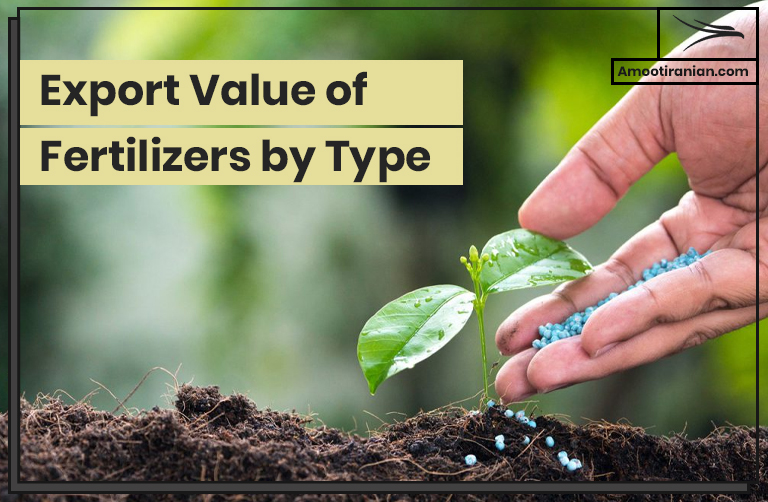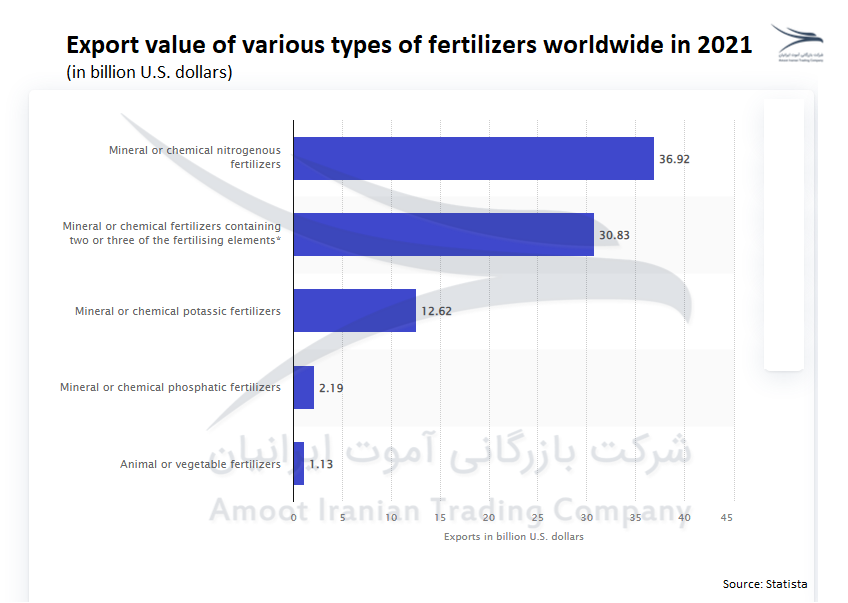.

The most valuable type of fertilizer export globally in 2021 was mineral or chemical nitrogenous fertilizers.
It exceeded USD 36.9 billion in value.
.
.
What Type of Fertilizers Had the Highest Export Value in 2021?
In 2021, the highest value of fertilizer exports worldwide was attributed to mineral or chemical nitrogenous fertilizers.
It was amounted to over USD 36.9 billion.
.

.
1. What Are Mineral or Chemical Nitrogenous Fertilizers?
Mineral or chemical nitrogenous fertilizers are synthetic fertilizers that are typically made from ammonia, which is produced through the Haber-Bosch process using natural gas as a raw material.
These fertilizers are rich in nitrogen.
.

.
Nitrogen is a vital nutrient for plant growth, and is used to supplement the natural supply of nitrogen in soil, thereby promoting plant growth and increasing crop yields.
Common examples of mineral or chemical nitrogenous fertilizers include:
- urea
- ammonium nitrate
- ammonium sulfate
.
2. What Is the Most Used Nitrogen Fertilizer?
Urea and ammonium sulfate are two of the most commonly used nitrogenous fertilizers in agriculture. .
Urea is a synthetic fertilizer that contains urea nitrogen, which is quickly converted into ammoniacal and nitrate nitrogen by soil bacteria.
Ammonium sulfate is also a synthetic fertilizer that contains ammoniacal nitrogen, which is readily converted into nitrate nitrogen by soil bacteria.
Both of these fertilizers are valued for their high nitrogen content, which makes them effective at promoting plant growth and increasing crop yields.
.
What Types of Fertilizer Were the Second Group of Fertilizers with the Highest Export Value in 2021?
Mineral or chemical fertilizers containing two or three of the fertilizing elements.
The export value of this group of fertilizers was USD 30.83 billion in 2021.
.
1. What Are Mineral or Chemical Fertilizers Containing Two or Three of the Fertilizing Elements?
Nitrogen (N), phosphorus (P), and potassium (K) are the primary fertilizing elements. Mineral or chemical fertilizers that contain two or three of these primary fertilizing elements are commonly referred to as compound fertilizers or NPK fertilizers.
.
These fertilizers are designed to provide a balanced nutrient supply to crops and can be customized to meet the specific needs of different crops and soil conditions.
.
2. Example of Mineral or Chemical Fertilizers Containing Two or Three of the Fertilizing Elements
For example, a compound fertilizer with an NPK ratio of 15-15-15 would contain:
- 15% nitrogen
- 15% phosphorus
- 15% potassium
.
Another example is a fertilizer with an NPK ratio of 20-10-10. It contains
- 20% nitrogen
- 10% phosphorus
- 10% potassium
.
These ratios can be adjusted to meet the specific requirements of different crops and soil types.
Compound fertilizers are widely used in agriculture because they are easy to handle and apply, and they provide a convenient way to deliver a balanced supply of nutrients to crops.
.
What Types of Fertilizer Were the Third Group of Fertilizers with the Highest Export Value in 2021?
Mineral or chemical potassic fertilizers.
The export value of this group of fertilizers was USD 12.62 billion in 2021.
.
1. What Are Mineral of Potassic Fertilizers?
Mineral or chemical potassic fertilizers are a type of fertilizer that provides potassium (K) as the primary nutrient to plants.
Potassium is one of the three primary macronutrients that plants need in relatively large amounts, along with nitrogen and phosphorus.
Potassium is important for plant growth and development, as it plays a role in regulating water balance, improving stress tolerance, and enhancing fruit quality.
.
2. Example of Mineral or Pottasic Fertilizers
Some examples of mineral or chemical potassic fertilizers include:
These fertilizers are typically mined from natural deposits, although they can also be produced synthetically through chemical processes.
.
Potassium chloride is the most commonly used potassic fertilizer, as it is readily available and relatively inexpensive.
Potassium sulfate is another commonly used potassic fertilizer, which contains both potassium and sulfur, another important plant nutrient.
Potassium nitrate is a specialty fertilizer that contains both potassium and nitrogen and is often used in high-value crops like fruits and vegetables.
.
What Types of Fertilizer Were the Fourth Group of Fertilizers with the Highest Export Value in 2021?
Mineral or phosphatic fertilizers.
The export value of this group of fertilizers was USD 2.19 billion in 2021.
.

.
1. What Are Mineral or Phosphatic Fertilizers?
Mineral or phosphatic fertilizers are a type of fertilizer that provides phosphorus (P) as the primary nutrient to plants.
Phosphorus is an essential macronutrient that plants need for various processes, including photosynthesis, energy transfer, and cell division.
.
2. Examples of Mineral or Phosphatic Fertilizers
Some examples of mineral or phosphatic fertilizers include:
- single superphosphate
- triple superphosphate
- diammonium phosphate
.
Single superphosphate is made by treating phosphate rock with sulfuric acid, which converts it into a more plant-available form.
Triple superphosphate is made by treating phosphate rock with phosphoric acid, which results in a higher concentration of phosphorus.
Diammonium phosphate is a specialty fertilizer that contains both phosphorus and nitrogen and is commonly used in agriculture.
.
Mineral or phosphatic fertilizers are important for promoting plant growth and increasing crop yields, particularly in soils that are deficient in phosphorus.
They are commonly used in agriculture and are often applied in combination with nitrogen and potassium fertilizers to provide a balanced nutrient supply to crops.
However, overuse of phosphatic fertilizers can lead to environmental problems like eutrophication, which is the excessive growth of algae in water bodies due to nutrient pollution.
.
What Types of Fertilizer Were the Fifth Group of Fertilizers with the Highest Export Value in 2021?
Animal or vegetable fertilizers.
The export value of this group of fertilizers was USD 1.13 billion in 2021.
.
1. What Are Animal or Vegetable Fertilizers?
Animal or vegetable fertilizers, also known as organic fertilizers, are fertilizers that are derived from natural sources
They include:
- animal manure
- plant residues
- other organic materials
.

.
These fertilizers contain a variety of nutrients that are essential for plant growth, including:
- nitrogen
- phosphorus
- potassium
- micronutrients (calcium, magnesium, & sulfur)
.
2. Examples of Animal or Vegetable Fertilizers
Animal-based organic fertilizers include manure from cows, horses, chickens, and other livestock, as well as fish emulsion and blood meal.
Vegetable-based organic fertilizers include compost, leaf mold, and green manure crops like clover and alfalfa.
.
Organic fertilizers are often preferred by some farmers and gardeners because they are considered more sustainable and environmentally friendly than synthetic fertilizers.
Organic fertilizers can also improve soil health by increasing the soil’s organic matter content, improving soil structure, and promoting beneficial soil microorganisms.
However, organic fertilizers typically have lower nutrient concentrations than synthetic fertilizers and can be more difficult to apply uniformly.
.

